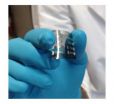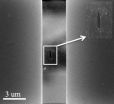(Press-News.org) Plastic and reconstructive surgeons leading the first retrospective study of all known facial transplants worldwide conclude that the procedure is relatively safe, increasingly feasible, and a clear life-changer that can and should be offered to far more carefully selected patients.
Reporting in The Lancet online April 27, NYU Langone plastic and reconstructive surgeon and senior author Eduardo Rodriguez, MD, DDS, says results after nearly a decade of experience with what he calls the "Mount Everest" of medical-surgical treatments are "highly encouraging."
The review team noted that the transplants still pose lifelong risks and complications from infection and sometimes toxic immunosuppressive drugs, but also are highly effective at restoring people to fully functioning lives after physically disfiguring and socially debilitating facial injuries.
Surgeons base their claims on the experience of 28 people known to have had full or partial face transplants since 2005, when the first such procedure was performed on a woman in France.
Of the 22 men and six women whose surgeries were reported, including seven Americans, none have chronically rejected their new organs and tissues, says Dr. Rodriguez, chair of the Department of Plastic Surgery at NYU Langone Medical Center and director of its Institute of Reconstructive Plastic Surgery. All but three recipients are still living. Four have returned to work or school.
Dr. Rodriguez, the Helen L. Kimmel Professor of Reconstructive Plastic Surgery at NYU Langone, in 2012 performed what is widely considered the most extensive facial transplant (when he practiced at the University of Maryland Medical Center in Baltimore). The patient was a Virginia man who had lost the lower half of his face in a gunshot accident 10 years earlier. Dr. Rodriguez is currently readying his new team at NYU Langone to perform its first facial transplantation, expected later this year.
In The Lancet article, Dr. Rodriguez and his colleagues point out that although all recipients to date have experienced some complications from infection, and mild to moderate signs of rejection, the few deaths among patients were due to infection and cancer not directly related to their transplants. Indeed, most patients, he says, especially those in the United States, are "thriving"—speaking, chewing, and leading social lives from which most had completely withdrawn because of their disfigurement.
"By far the overriding factor in the success of face transplantation has been in selecting patients most likely to benefit from and succeed through what can best be described as the most complex of medical-surgical procedures," says Dr. Rodriguez. "This is a life-changing treatment that can take years to prepare for and one that hopefully endures for the rest of the patient's life."
Dr. Rodriguez notes that only patients with the most severe facial disfigurement—not reparable by even the latest surgical techniques—are considered for the procedure. Patient histories range from victims of bear bites to multiple gunshot accidents and severe, electrical and house fire burn injuries. The extent of injuries may encompass any combination of the forehead, eyelids, nose, cheeks, lips, jaws, and chin.
"People who volunteer to undergo this procedure do so for very serious health and psychological reasons," says Dr. Rodriguez. "It goes far deeper than looks. People willing to undergo facial transplantation are highly motivated to do so. Without facial transplantation as an option, many of these people would be at serious risk for severe depression, even potential suicide," he says.
For those who do undergo facial transplantation, Dr. Rodriguez says success depends heavily on "total compliance" with their medication regiment and intense follow-up care. They must take immunosuppressive drugs as prescribed to ward off organ and tissue rejection, watch for early signs of infection, and keep up with their physical, occupational, and speech rehabilitation regimens. Having a strong family support system greatly helps.
Psychological improvements have been steep, the surgeons report in The Lancet, with most transplant recipients declaring a renewed sense of self and body image, showing fewer signs of depression, and experiencing fewer episodes of verbal outbursts than before their transplant. None had signs, as originally feared, of a "split" personality, in which they assumed their donor's identity. Indeed, donor family members say recipients do not even resemble their donors after the surgical transformation. Dr. Rodriguez attributes this to the rigorous psychological screening and counseling that preceded surgery.
Because facial transplantation is life-changing and not life-saving, Dr. Rodriguez points out that the procedure still raises grave concerns about the ethics of putting otherwise healthy, mostly young people on a lifetime regimen of toxic immunosuppressive drugs and at risk of potentially fatal infections and vital organ compromise.
"These moral considerations must be taken very seriously as the number of face transplants and medical centers equipped to perform them grows," says Dr. Rodriguez. "We have the medical ability to restore these people's lives. With some victims from fire, police and military armed services, it can be argued that we have a moral imperative to restore them to society."
Despite accelerated psychological recovery in many cases, physical recovery can take years, the surgeons report. While recipients claim feeling sensations of cold and heat as early as a few months after surgery, sensing touch and pain on the skin often takes eight months or longer, as does recipients' ability to open and close their mouths and move their lips.
For some, speech, smelling, chewing, and swallowing abilities can resume within months and rapidly improve within a year. Relearning how to smile and drink fluids, though, takes as long as two years. Powerful drugs are used to accelerate nerve repair and growth.
Surgical revisions to properly align teeth and jaw bones are common among the transplant recipients, in addition to cosmetic procedures to smoothen facial contours and remove excess skin. Complications have been few, the report states.
In the article, Dr. Rodriguez and his colleagues also note the significant financial costs and the serious ethical debate around them. The procedures cost roughly $300,000 each, not including fees associated with a lifetime of immunosuppressive therapy or need for additional surgery. These costs, they conclude, are only sustainable in the long term with committed public funding.
Dr. Rodriguez says his team at NYU Langone plans further research on developing better tools for screening patients best suited to the lifelong therapy and determining the relative value of full or partial face transplants. Additional efforts to forge a standardized surgical protocol will focus on complex instructions about how best to position and fit the new face and underlying bone, as well as match and attach nerves and muscle. The NYU Langone team also plans studies on the long-term health effects of immunosuppressive therapies and whether dose reductions are possible to lessen drug toxicity without compromising risk of organ rejection. The team also plans to explore the feasibility of performing face transplants on severely disfigured children.
In placing the first decade of facial transplantation in historical context, Dr. Rodriguez compares it to the beginnings of liver transplantation in the 1960s, when few procedures were performed and few patients lived longer than a year. Today, he says, liver transplantation is performed at more than 100 medical centers in the U.S. alone, and the vast majority of patients, including children, survive beyond a year, with outcomes continuously improving despite liver transplantation's frequent complications.
"We are still very much in the early days of facial transplantation," says Dr. Rodriguez. "So long as our patients need it—and they do—then, it is our medical duty to continue to advance science and medicine, and improve how we perform the procedure so that it is more widely available to future generations of people whose severe disfigurements go beyond the means of conventional surgery."
INFORMATION:
Other plastic and reconstructive surgeons involved in preparing the report include Philip Brazio, MD; Raja Mohan, MD; Cynthia Shaffer, MS, MBA; and Rolf Barth, MD, at the University of Maryland Medical Center; and Saami Khalifan, MD; Raja Mohan, MD; and Gerald Brandacher, MD, at the Johns Hopkins Hospital, both in Baltimore, Md.
For more information, go to:
http://communications.med.nyu.edu/media-relations/news/eduardo-d-rodriguez-md-dds-named-chair-department-plastic-surgery-nyu-langone-m
http://www.thelancet.com/
About NYU Langone Medical Center:
NYU Langone Medical Center, a world-class, patient-centered, integrated academic medical center, is one of the nation's premier centers for excellence in clinical care, biomedical research, and medical education. Located in the heart of Manhattan, NYU Langone is composed of four hospitals—Tisch Hospital, its flagship acute care facility; Rusk Rehabilitation; the Hospital for Joint Diseases, the Medical Center's dedicated inpatient orthopaedic hospital; and Hassenfeld Children's Hospital, a comprehensive pediatric hospital supporting a full array of children's health services across the Medical Center—plus the NYU School of Medicine, which since 1841 has trained thousands of physicians and scientists who have helped to shape the course of medical history. The Medical Center's tri-fold mission to serve, teach, and discover is achieved 365 days a year through the seamless integration of a culture devoted to excellence in patient care, education, and research. For more information, go to http://www.NYULMC.org, and interact with us on Facebook, Twitter, and YouTube.
Media Inquiries:
David March
212.404.3528│david.march@nyumc.org
Facial transplantation: Almost a decade out, surgeons prepare for burgeoning demand
A review of all 28 patients to date, including 7 Americans, reveals challenges but 'moral imperative' to offer the lifelong, life-changing treatment
2014-04-29
ELSE PRESS RELEASES FROM THIS DATE:
Stroke risk reduced if brain blood vessel disorder is left alone
2014-04-29
Treating patients who suffer from a common condition that affects blood vessels in the brain increases their risk of stroke, a study has found.
People with a condition known as arteriovenous malformation (AVM) – which causes blood vessels in the brain to tangle – have a better outcome if doctors treat their symptoms only and not the AVM.
A team of doctors looked at the long-term outcome of patients with the condition, which is caused by abnormal connections between the arteries and veins in the brain.
They found that, over a 12 year period, patients who chose not ...
In a commanding position -- and now cheaper
2014-04-29
It is a requirement of the touchscreens for all our everyday gadgets that they are transparent and at the same time electrically conductive. Solar cells are also unable to operate without such a film, which allows sunlight to pass through it, but can also conduct the current generated. Conventional "transparent conductive oxide" (TCO) films consist of a mixture of indium and tin oxide. Indium in very much in demand in the electronics industry, but is rare, and therefore expensive.
A cheaper option (at least in terms of the materials used) employs zinc oxide mixed with ...
Study highlights importance of parents talking to kids about money
2014-04-29
A new study from North Carolina State University and the University of Texas finds that children pay close attention to issues related to money, and that parents should make an effort to talk with their children to ensure that kids don't develop misconceptions about finance.
"We wanted to know what kids are learning, or not learning, about money from their parents," says Dr. Lynsey Romo, an assistant professor of communication at NC State and lead author of a paper on the research. "This is one of the first studies to look at what young school-age children know about ...
Man landing on Madeira could be 4 centuries prior to its colonization by the Portuguese
2014-04-29
VIDEO:
Four centuries before its colonization by the Portuguese, man may have landed on Madeira Island. This can be deduced from a study led by the Spanish National Research Council (CSIC),...
Click here for more information.
According to the results, published in the Proceedings of the Royal Society B journal, house mice may have landed on the island before 1036, most likely transported by a ship. The article suggests that the introduction of this species would result in an ...
Immunology touted as next big thing for popular science
2014-04-29
A University of Manchester professor says scientific jargon could be making the science of the human immune system a turn-off for the general public.
Professor Daniel Davis says that scientists are using a number of innovative ways to generate public discussion on immunology and the time is right for people to get to grips with the subject.
His paper, published today in Nature Reviews Immunology, coincides with the International Day of Immunology, argues that now is the right time for immunology to become the next big trend in popular science – to inform new discussions ...
Nutrition experts chew the fat at ASN satellite symposium
2014-04-29
(San Diego, CA) April 25, 2014 – More research is needed to better understand the important role that dietary fats play in optimal health, said a panel of leading food and nutrition scientists Friday at an American Society for Nutrition (ASN) pre-annual meeting session.
More than 130 academic and industry food and nutrition scientists and registered dietitians attended the half-day ASN Satellite Symposium: Let's Chew the Fat: Current Thinking on Dietary Fats and the Food We Eat, held from 1-5 pm at the San Diego Bayfront Hilton in conjunction with the ASN's 78th Scientific ...
Adhesion molecule shows promise for treating colitis
2014-04-29
Philadelphia, PA, April 28, 2014 – The adhesion molecule CD146 plays a vital role in inflammation and offers a promising therapeutic target for treating inflammatory bowel disease (IBD) as well as preventing colitis-associated colorectal cancer, say scientists. Targeting CD146 with anti-CD146 antibody AA98, especially in combination with an anti-TNF-alpha antibody, showed promising results in mice. Their report is published in The American Journal of Pathology.
Enhanced CD146 expression has been reported on endothelial cells in intestinal biopsies from patients with inflammatory ...
'Let it go,' but not in the boardroom
2014-04-29
While Disney's Frozen Academy Award-winning diva anthem "Let It Go" has dominated the Billboard 200, sales records and parents' eardrums with its message of all-out emotional display, that approach probably won't always resonate in the boardroom, according to a recent study from Marshall and USC faculty.
"A business person in a negotiation," said Peter Carnevale, professor of management and organization at USC's Marshall School of Business, "should be careful about managing his or her emotions because the person across the table is making inferences based on facial expressions. ...
Graphene only as strong as weakest link
2014-04-29
HOUSTON – (April 29, 2014) – There is no disputing graphene is strong. But new research by Rice University and the Georgia Institute of Technology should prompt manufacturers to look a little deeper as they consider the miracle material for applications.
The atom-thick sheet of carbon discovered this century is touted not just for its electrical properties but also for its physical strength and flexibility. The bonds between carbon atoms are well known as the strongest in nature, so a perfect sheet of graphene should withstand just about anything. Reinforcing composite ...
Urban river pollutants suppress wild bird development
2014-04-29
New research indicates that hormone disrupting pollutants are affecting the health and development of wild birds nesting along the urban rivers of South Wales.
Findings published today in the Environmental Toxicology and Chemistry journal reveal that chicks of the Eurasian Dipper – a river bird that feeds exclusively on insects and fish in upland streams – are underweight compared to their rural counterparts. Also of concern is that birds nesting in urban rivers have altered hormone levels, and are hatching fewer female chicks than those nesting along rural rivers, ...
LAST 30 PRESS RELEASES:
Tracing the quick synthesis of an industrially important catalyst
New software sheds light on cancer’s hidden genetic networks
UT Health San Antonio awarded $3 million in CPRIT grants to bolster cancer research and prevention efforts in South Texas
Third symposium spotlights global challenge of new contaminants in China’s fight against pollution
From straw to soil harmony: International team reveals how biochar supercharges carbon-smart farming
Myeloma: How AI is redrawing the map of cancer care
Manhattan E. Charurat, Ph.D., MHS invested as the Homer and Martha Gudelsky Distinguished Professor in Medicine at the University of Maryland School of Medicine
Insilico Medicine’s Pharma.AI Q4 Winter Launch Recap: Revolutionizing drug discovery with cutting-edge AI innovations, accelerating the path to pharmaceutical superintelligence
Nanoplastics have diet-dependent impacts on digestive system health
Brain neuron death occurs throughout life and increases with age, a natural human protein drug may halt neuron death in Alzheimer’s disease
SPIE and CLP announce the recipients of the 2025 Advanced Photonics Young Innovator Award
Lessons from the Caldor Fire’s Christmas Valley ‘Miracle’
Ant societies rose by trading individual protection for collective power
Research reveals how ancient viral DNA shapes early embryonic development
A molecular gatekeeper that controls protein synthesis
New ‘cloaking device’ concept to shield sensitive tech from magnetic fields
Researchers show impact of mountain building and climate change on alpine biodiversity
Study models the transition from Neanderthals to modern humans in Europe
University of Phoenix College of Doctoral Studies releases white paper on AI-driven skilling to reduce burnout and restore worker autonomy
AIs fail at the game of visual “telephone”
The levers for a sustainable food system
Potential changes in US homelessness by ending federal support for housing first programs
Vulnerability of large language models to prompt injection when providing medical advice
Researchers develop new system for high-energy-density, long-life, multi-electron transfer bromine-based flow batteries
Ending federal support for housing first programs could increase U.S. homelessness by 5% in one year, new JAMA study finds
New research uncovers molecular ‘safety switch’ shielding cancers from immune attack
Bacteria resisting viral infection can still sink carbon to ocean floor
Younger biological age may increase depression risk in older women during COVID-19
Bharat Innovates 2026 National Basecamp Showcases India’s Most Promising Deep-Tech Ventures
Here’s what determines whether your income level rises or falls
[Press-News.org] Facial transplantation: Almost a decade out, surgeons prepare for burgeoning demandA review of all 28 patients to date, including 7 Americans, reveals challenges but 'moral imperative' to offer the lifelong, life-changing treatment


